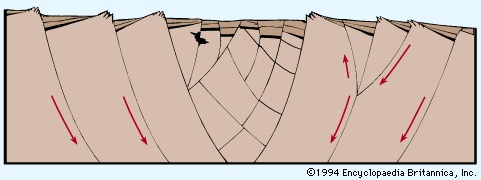tectonic landform
geology
any of the relief features that are produced chiefly by uplift or subsidence of the Earth's crust or by upward magmatic movements. They include mountains, plateaus, and rift valleys.
Whereas erosion shapes landforms, their origins lie in tectonic processes that build the major structures of the Earth. The word tectonic is derived from the Greek word tekton, which means “builder.” Tectonic processes build landforms mainly by causing the uplift or subsidence of rock material—blocks, layers, or slices of the Earth's crust, molten lavas, and even large masses that include the entire crust and uppermost part of the planet's mantle. In some areas, these processes create and maintain high elevations such as mountains and plateaus. In others, they produce topographic depressions, as exemplified by Death Valley in the western United States, the Dead Sea in the Middle East, or the Turfan Depression in western China. Virtually all areas below sea level have been formed by tectonic processes.
 Mountain ranges and plateaus result either from the uplift of the Earth's surface or from the emplacement of volcanic rock onto the surface. Many mountain ranges consist of chains of volcanoes that are made up of rocks derived from depths of tens of kilometres below the surface. Some plateaus are created by huge outpourings of lavas over vast areas. In addition, the intrusion of molten rock into the crust from below can raise the surface. Many other mountain ranges have been formed by the overthrusting of one terrain or block of crust over an adjacent one, which is another mechanism that uplifts the surface (Figure 1-->
Mountain ranges and plateaus result either from the uplift of the Earth's surface or from the emplacement of volcanic rock onto the surface. Many mountain ranges consist of chains of volcanoes that are made up of rocks derived from depths of tens of kilometres below the surface. Some plateaus are created by huge outpourings of lavas over vast areas. In addition, the intrusion of molten rock into the crust from below can raise the surface. Many other mountain ranges have been formed by the overthrusting of one terrain or block of crust over an adjacent one, which is another mechanism that uplifts the surface (Figure 1--> ). Similarly, the folding of rocks at the surface creates the ridges and valleys that define some mountain chains. These processes of overthrusting (or underthrusting) and folding result from horizontal forces that cause crustal shortening (in its horizontal dimension) and crustal thickening. Finally, heating and thermal expansion of the outer 100 to 200 kilometres of the Earth can uplift broad areas into either mountain ranges or plateaus.
). Similarly, the folding of rocks at the surface creates the ridges and valleys that define some mountain chains. These processes of overthrusting (or underthrusting) and folding result from horizontal forces that cause crustal shortening (in its horizontal dimension) and crustal thickening. Finally, heating and thermal expansion of the outer 100 to 200 kilometres of the Earth can uplift broad areas into either mountain ranges or plateaus. Similarly, tectonic valleys, basins, and depressions of smaller size can form by the reverse of two of the processes mentioned above. Crustal extension (in its horizontal dimension) and crustal thinning occur where two blocks of crust move apart; a valley or basin forms between such blocks where the intervening segment of crust has been thinned and its top surface subsides (Figure 2-->
Similarly, tectonic valleys, basins, and depressions of smaller size can form by the reverse of two of the processes mentioned above. Crustal extension (in its horizontal dimension) and crustal thinning occur where two blocks of crust move apart; a valley or basin forms between such blocks where the intervening segment of crust has been thinned and its top surface subsides (Figure 2--> ). Likewise, subsidence of the Earth's surface can occur by the cooling and the thermal contraction of the outer 100 kilometres of the planet. Plateaus and entire mountain ranges can subside by this mechanism to form large basins in some areas.
). Likewise, subsidence of the Earth's surface can occur by the cooling and the thermal contraction of the outer 100 kilometres of the planet. Plateaus and entire mountain ranges can subside by this mechanism to form large basins in some areas.Virtually all large-scale landforms are the result of both tectonic processes that built the large differences in elevation and erosional processes that sculpted the relief of such areas into their individual shapes. Thus, it might be said that tectonic processes built the Alps, but erosional processes gave the Matterhorn its unique profile. In all cases, erosion acts to reduce differences in elevation, but when the rate of erosion is not too rapid, landforms created by tectonic processes can persist for hundreds of millions of years after the processes have ceased to operate.
Additional Reading
An excellent introduction to geology, somewhat dated but very well illustrated, is Arthur Holmes, Principles of Physical Geology, 2nd rev. ed. (1965), with a particularly good treatment of rift valleys. William J. Perry, Dietrich H. Roder, and David R. Lageson (comps.), North American Thrust-Faulted Terranes (1984), is a collection of technical papers describing segments of folded and thrusted mountain belts in North America and the mechanics of such deformation. Introductory articles on volcanism at hot spots and island arcs include K. Burke and T. Wilson, “Hot Spots on the Earth's Surface,” Scientific American, 235(2):46–57 (August 1976); and Bruce D. Marsh, “Island-Arc Volcanism,” American Scientist, 67(2):161–172 (March-April 1979). A discussion of the forces that support mountain ranges and how some ranges are constructed can be found in Peter Molnar, “The Structure of Mountain Ranges,” Scientific American, 255(1):70–79 (July 1986).